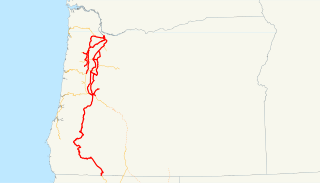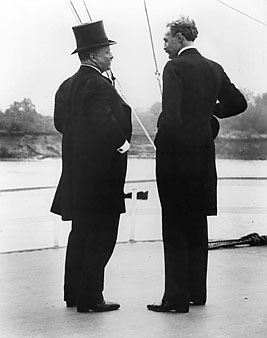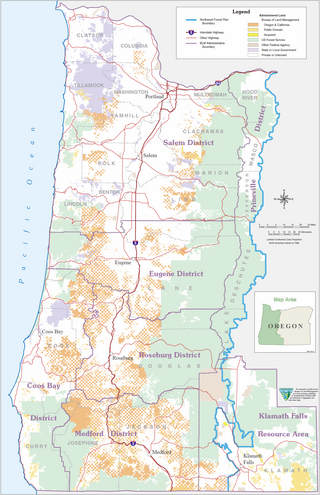Olympic National Forest is a U.S. National Forest located in Washington, USA. With an area of 628,115 acres (254,189 ha), it nearly surrounds Olympic National Park and the Olympic Mountain range. Olympic National Forest contains parts of Clallam, Grays Harbor, Jefferson, and Mason counties. The landscape of the national forest varies, from the temperate Olympic rain forest to the salt water fjord of Hood Canal to the peaks of Mt. Washington.

The Oregon and California Railroad was formed from the Oregon Central Railroad when it was the first to operate a 20-mile (32 km) stretch south of Portland in 1869. This qualified the railroad for land grants in California, whereupon the name of the railroad soon changed to Oregon & California Rail Road Company. In 1887, the line was completed over Siskiyou Summit, and the Southern Pacific Railroad assumed control of the railroad, although it was not officially sold to Southern Pacific until January 3, 1927. This route was eventually spun off from the Southern Pacific as the Central Oregon and Pacific Railroad.

Darlene Kay Olson Hooley is an American politician and former Democratic member of the U.S. House of Representatives from Oregon who represented the state's 5th congressional district.

Walter Leslie AuCoin is an American politician. In 1974 he became the first person from the Democratic Party to be elected to the U.S. House of Representatives from Oregon's 1st congressional district, since it was formed in 1892. The seat has been held by Democrats ever since.

The General Revision Act of 1891, also known as the Forest Reserve Act of 1891, was a federal law signed in 1891 by President Benjamin Harrison. The Act reversed previous policy initiatives, such as the Timber Culture Act of 1873, which did not preclude land fraud by wealthy individuals and corporations. The acquisition of vast mineral and timber resources in the Western United States was often cited as a governing motive for such individuals and corporations to claim land rights for future settlement and resource depletion activities. The legacy of the General Revision Act of 1891 is frequently credited as its serving as a catalyst to a series of federal land reform initiatives, notably under President Theodore Roosevelt. From the Reclamation Act of 1902 to the formation of the United States Forest Service in 1905, the General Revision Act of 1891 acted as a critical first piece of federal legislation granting increased plots of publicly allotted land and decreased extraction rights to privately held western land owners in the early 20th century.

The Wilderness Society is an American non-profit land conservation organization that is dedicated to protecting natural areas and federal public lands in the United States. They advocate for the designation of federal wilderness areas and other protective designations, such as for national monuments. They support balanced uses of public lands, and advocate for federal politicians to enact various land conservation and balanced land use proposals. The Wilderness Society also engages in a number of ancillary activities, including education and outreach, and hosts one of the most valuable collections of Ansel Adams photographs at their headquarters in Washington, D.C.

Oregon Ballot Measure 37 was a controversial land-use ballot initiative that passed in the U.S. state of Oregon in 2004 and is now codified as Oregon Revised Statutes (ORS) 195.305. Measure 37 has figured prominently in debates about the rights of property owners versus the public's right to enforce environmental and other land use regulations. Voters passed Measure 49 in 2007, substantially reducing the impact of Measure 37.
The Coquille Indian Tribe is the federally recognized Native American tribe of the Coquille people who have traditionally lived on the southern Oregon Coast.

The Oregon land fraud scandal of the early 20th century involved U.S. government land grants in the U.S. state of Oregon being illegally obtained with the assistance of public officials. Most of Oregon's U.S. congressional delegation received indictments in the case: U.S. Senator John H. Mitchell and U.S. Representatives John N. Williamson and Binger Hermann, with Senator Charles William Fulton singularly uninvolved.

Abraham Walter Lafferty was a U.S. Representative from the state of Oregon. Lafferty spent the majority of his career both as a legislator and as an attorney attempting to have millions of acres of land previously owned by the Oregon and California Railroad come under Oregon state control, rather than the control of the U.S. federal government.
The Northwest Forest Plan (NWFP) is a series of federal policies and guidelines governing land use on federal lands in the Pacific Northwest region of the United States. It covers 10 million hectares within Western Oregon and Washington, as well as a small part of Northern California.

The Florida black bear is a subspecies of the American black bear that has historically ranged throughout most of Florida and the southern portions of Georgia, Alabama, and Mississippi. The large black-furred bears live mainly in forested areas and have seen recent habitat reduction throughout the state due to increased human development, as well as habitat modifications within bear habitat.
The Oregon Land Conservation and Development Act of 1973, formally Oregon Senate Bills 100 and 101 of 1973, were pieces of landmark legislation passed by the Oregon State Senate in 1973 and later signed into law. It created a framework for land use planning across the state, requiring every city and county to develop a comprehensive plan for land use.

The Willamette River Greenway is a cooperative state and local government effort to maintain and enhance the scenic, recreational, historic, natural and agricultural qualities of the Willamette River and its adjacent lands. A number of trails exist along the greenway, but significant gaps still exist.

Starting in 1876, and undergoing a series of name changes, the United States Forest Service of the Department of Agriculture grew to protect and use millions of acres of forest on public land. Gifford Pinchot, an early advocate of scientific forestry, along with President Theodore Roosevelt and conservation organizations, led the effort to manage forest for the public good.
The Secure Rural Schools and Community Self-Determination Act of 2000 was a bill passed into law by the United States Congress on October 30, 2000. The law amended the United States Forest Service's county payments program for FY2001-FY2006 to allow states or counties to choose to receive the average of the three highest payments for FY1986-FY1999 in lieu of the regular 25% payment, but requiring that 15–20% of those payments be used by the counties for specified purposes, in accordance with recommendations of resource advisory committees for projects on federal lands, or returned to the Treasury.

Gilchrist State Forest is the sixth and newest state forest in the U.S. state of Oregon. The forest is located in northern Klamath County near the community of Gilchrist and was officially dedicated on June 11, 2010. The forest sits along U.S. Route 97 and is 70,000 acres (28,000 ha) in size.
The Coos Bay Wagon Road Lands is land managed by the United States Bureau of Land Management. The land was originally granted to the Oregon & California Railroad to create a road between Coos Bay, Oregon, and Roseburg, Oregon. The land was reconveyed to the United States in 1937.

The Oregon and California Railroad Revested Lands, are approximately 2,600,000 acres (1,100,000 ha) of land located in eighteen counties of western Oregon. Originally granted to the Oregon & California Railroad to build a railroad between Portland, Oregon and San Francisco, California, the land was reconveyed to the United States government by act of Congress in 1916 and is currently managed by the United States Bureau of Land Management.

The John D. Dingell Jr. Conservation, Management, and Recreation Act of 2019 is an omnibus lands act that protected public lands and modified management provisions. The bill designated more than 1,300,000 acres (5,300 km2) of wilderness area, expanded several national parks and other areas of the National Park System, and established four new national monuments while redesignating others. Other provisions included making the Land and Water Conservation Fund permanent, protecting a number of rivers and historic sites, and withdrawing land near Yellowstone National Park and North Cascades National Park from mining.














